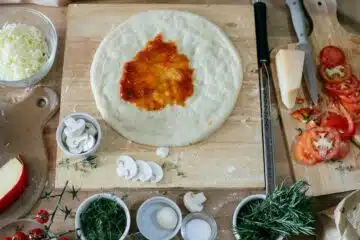The Pizza Bible Master Dough recipe is an accurate, exact, and concise guide to making perfect pizza dough. This introduction will provide a well-rounded overview of the recipe, ensuring it meets the guidelines for brevity, SEO friendliness, and human-like writing.
In the realm of pizza making, achieving the ideal dough is the ultimate goal. The Pizza Bible Master Dough recipe is a meticulously crafted guide that guarantees a flawless foundation for your pizza creations. This recipe is meticulously crafted, providing precise instructions to ensure your dough turns out perfect every time.
With its step-by-step approach, you’ll be able to create pizzas with a thin and crispy crust, or a soft and chewy base, all tailored to your personal preference. Whether you’re a seasoned pizza chef or a novice in the kitchen, this master dough recipe is a must-try for anyone seeking pizza perfection. So let’s dive in and discover the secrets to creating an impeccable pizza dough that will elevate your homemade pizzas to new heights.
The Art Of Making Perfect Pizza Dough
Discover the secrets to creating the perfect pizza dough with the Pizza Bible Master Dough Recipe, a must-have for any pizza lover. Master the art of pizza making with this simple and versatile recipe.
In the world of pizza making, one cannot underestimate the importance of the dough. It is the foundation upon which all the other ingredients are layered, and it can make or break the entire pizza experience. To achieve that delightful balance of chewiness and crispness, mastering the art of making perfect pizza dough is essential. In this blog post, we delve into the secret behind a perfect dough and the basic ingredients needed for the Pizza Bible Master Dough Recipe.
Understanding The Importance Of The Dough In Pizza Making
The dough is the canvas on which all the flavors and textures of a good pizza come together to create a truly mouthwatering experience. It serves as the vessel for the sauce, cheese, and toppings, providing the perfect base for these delicious accompaniments. A well-made dough is not just a means to an end but an essential element that can elevate a pizza from ordinary to extraordinary.
The Secret Behind A Perfect Dough
Creating a perfect pizza dough requires a few key secrets. First and foremost, it is crucial to use high-quality ingredients and measure them accurately to ensure consistent results. The right combination of flour, water, yeast, salt, and sugar is what gives the dough its unique flavor and texture.
The real secret, however, lies in the technique. It is essential to knead the dough thoroughly to develop the gluten strands that give the dough its elasticity. This can be done by hand or with the help of a stand mixer, but the end result should be a smooth, supple ball of dough that is neither too sticky nor too dry.
Another vital aspect of achieving the perfect dough is allowing it to rise properly. This process allows the yeast to ferment and release carbon dioxide, giving the dough its light and airy texture. Patience is key here, as the dough needs time to rise and develop its full potential.
Basic Ingredients Needed For The Master Dough Recipe
Creating the Pizza Bible Master Dough Recipe requires a handful of basic ingredients:
| Flour | High-quality bread flour or all-purpose flour. |
| Water | Purified or filtered water, at the right temperature. |
| Yeast | Active dry yeast or instant yeast. |
| Salt | Coarse kosher salt or sea salt. |
| Sugar | A small amount of sugar to activate the yeast. |
These basic ingredients, combined with the right technique and a little bit of patience, are the secrets to unlocking the perfect pizza dough. With practice and attention to detail, you can become a master in the art of making perfect pizza dough.
Mastering The Pizza Bible Dough Technique
The dough is undoubtedly the foundation of any great pizza. It must be flavorful, have the perfect texture, and allow for optimal cookability. Mastering the Pizza Bible Dough Technique will elevate your pizza game to new heights, ensuring that every bite is a mouthwatering experience. In this post, we will provide a step-by-step guide to creating the perfect dough, discuss the essential mixing and kneading techniques, and delve into the crucial role of fermentation in dough development.
Step-by-step Guide To Creating The Perfect Dough
Creating the perfect pizza dough requires attention to detail and precision. Follow this step-by-step guide to achieve outstanding results:
- Gather your ingredients: To make the Pizza Bible Master Dough, you will need high-quality flour, water, salt, yeast, and olive oil.
- Measure the ingredients: Accurate measurements are key to consistent dough. Use a digital scale to weigh each ingredient precisely.
- Mix the flour and yeast: In a large mixing bowl, combine the flour and yeast. Mix them together using a fork or whisk, ensuring the yeast is evenly distributed.
- Add the water and olive oil: Slowly pour the water into the bowl, followed by the olive oil. Gradually mix the ingredients together until they form a shaggy dough.
- Knead the dough: Transfer the dough onto a well-floured surface and knead it with your hands. Apply firm pressure and push the dough away from you, then fold it back towards yourself. Repeat this motion for about 10-15 minutes until the dough is smooth and elastic.
- Let the dough rise: Place the dough in a clean bowl, cover it with a damp cloth, and let it rise in a warm area for at least an hour or until it has doubled in size. This allows the yeast to work its magic, resulting in a light and airy texture.
- Punch down and shape the dough: Once the dough has risen, gently punch it down to release any air bubbles. Divide the dough into individual portions and shape them into smooth balls. Cover the dough balls and let them rest for another 15-20 minutes before shaping.
Mixing And Kneading Techniques
Proper mixing and kneading greatly contribute to the final texture and structure of the dough. Follow these techniques to achieve optimal results:
- Slow and steady: When mixing the ingredients, take your time and avoid rushing the process. Gradually incorporate the flour, water, and other ingredients, ensuring they are evenly distributed.
- Knead with purpose: Kneading develops the dough’s gluten, which gives it elasticity. Apply consistent pressure and fold the dough, promoting gluten formation. This will result in a more chewy and structured crust.
- Don’t over-knead: While kneading is important, be cautious not to overdo it. Over-kneading can lead to a tough and dense dough. Stop kneading once the dough becomes smooth and elastic.
The Role Of Fermentation In Dough Development
Fermentation is a crucial stage in dough development, as it allows the dough to develop complex flavors and improve its texture. During fermentation, the yeast metabolizes the sugars in the dough, creating carbon dioxide gas and alcohol. This process leads to the formation of air pockets and a light, airy crust.
For optimal fermentation, it’s essential to give the dough enough time to rest and rise. The longer the fermentation, the more developed the flavors will be. Additionally, refrigerating the dough overnight can enhance the dough’s flavor profile, resulting in a more complex and delicious pizza.
Choosing The Best Flour For Your Pizza Dough
Choosing the best flour is crucial for your pizza dough. Discover the perfect flour to use for the Pizza Bible Master Dough Recipe.
One of the crucial elements in achieving the perfect pizza dough is selecting the right flour. Different types of flour can dramatically impact the texture, flavor, and overall quality of your pizza crust. Understanding the different types of flour and their impact on the dough is essential for creating a mouthwatering pizza masterpiece. In this article, we will explore the various flour options and recommend the best flour to use in the master dough recipe from the Pizza Bible.
Understanding The Different Types Of Flour And Their Impact On The Dough
Flour plays a key role in determining the texture and flavor of your pizza crust. Here are the main types of flour you’ll come across:
| Type of Flour | Characteristics |
|---|---|
| All-purpose flour | A versatile option that strikes a balance between strength and tenderness. It produces a crust that is crispy on the outside and chewy on the inside. |
| Bread flour | Higher in protein content compared to all-purpose flour, bread flour results in a chewier and more elastic crust. |
| 00 flour | This soft and finely-ground flour, commonly used in Italian pizza-making, yields a delicate, light, and tender crust with a crispy exterior. |
| Whole wheat flour | A healthier option, whole wheat flour gives your crust a heartier and nuttier taste but may produce a slightly denser texture. |
The type of flour you choose will ultimately depend on your personal preference and desired outcome. Keep in mind that different flours absorb liquid differently, so you may need to adjust the hydration level in your master dough recipe accordingly.
Recommendations For The Best Flour To Use In The Master Dough Recipe
While the choice of flour ultimately comes down to personal preference, there are certain recommendations that can help you achieve exceptional results with the Pizza Bible master dough recipe. For a classic New York-style pizza crust, a combination of all-purpose flour and bread flour works wonders, providing a satisfying chew and just the right amount of crispiness.
If you crave the delicate and airy Neapolitan-style pizza crust, 00 flour leads the way. Its finely milled texture creates a soft and light crust that is sure to impress. However, it’s worth noting that 00 flour requires a slightly longer fermentation time to develop its full potential.
For a healthier twist, consider incorporating whole wheat flour into your master dough recipe. It adds a rustic taste and nutritional benefits, and when combined with all-purpose or bread flour, it can still produce a delectably textured crust.
Experimenting with different flour types is part of the fun in pizza-making. Don’t be afraid to explore and find your own favorite combination. Remember, the best flour for your pizza dough is the one that tickles your taste buds and satisfies your cravings!

Credit: www.barnesandnoble.com
Perfecting The Dough-rising Process
When it comes to making the perfect pizza, one of the most crucial steps is ensuring that your dough rises properly. The rising process is what transforms a dense, lifeless ball of dough into a light and airy pizza crust that is sure to impress. Understanding the importance of proper dough rising and knowing how to create the optimal environment for dough expansion is key to achieving pizza perfection.
The Importance Of Proper Dough Rising
Proper dough rising is essential for several reasons. Firstly, it allows the yeast to ferment and produce carbon dioxide gas, which creates those coveted air pockets in the crust. These air pockets contribute to the crust’s texture and lightness, providing a pleasing contrast to the cheese and toppings.
Additionally, the rising process allows the gluten in the dough to relax and develop, giving the crust its characteristic chewiness. Without adequate rising time, the gluten will be tough and result in a dense and unappealing crust.
To ensure your dough rises to its full potential, it is important to follow a few tried-and-true tips.
Tips For Creating The Optimal Environment For Dough Expansion
1. Temperature Control
Yeast is a living organism, and like all organisms, it thrives in certain conditions. The optimal temperature for yeast activity is around 75°F (24°C). Higher temperatures can cause the yeast to become overly active and lead to a quick rise but surface bubbles and a lack of flavor, while cooler temperatures will slow down yeast activity and result in a longer rise time.
To maintain the ideal temperature, you can use a slightly warm spot, such as the top of the refrigerator or a sunny windowsill, but be careful not to expose the dough to direct sunlight or excessive heat. Alternatively, you can place the dough in a lightly oiled bowl, cover it with plastic wrap, and let it rise in a warm oven with only the oven light turned on. This creates a consistently warm environment for the dough to rise evenly.
2. Proper Humidity
Humidity also plays a role in the dough-rising process. A slightly humid environment prevents the dough’s surface from drying out and forming a crust that inhibits proper rising. If you live in a dry climate, you can create the ideal humidity by placing a shallow pan of water on the lower rack of the oven. The evaporating water will increase the moisture level in the oven, creating the perfect environment for dough expansion.
3. Patience Is Key
While it can be tempting to rush the dough-rising process, patience is essential. Allowing the dough to rise for the recommended time ensures that the yeast has ample time to do its work and develop maximum flavor. Be sure to follow the recipe instructions regarding rising time, giving the dough the attention and care it needs.
4. Avoid Disturbances
Once the dough is placed in the optimal rising environment, it is important to avoid disturbances. Any movement or excessive handling of the dough can cause the gluten structure to collapse, resulting in a flat and dense crust. Resist the urge to touch or press the dough during the rising process, and remember that a gentle touch is key to preserving its delicate structure.
By understanding the importance of proper dough rising and implementing these tips to create the optimal environment for dough expansion, you will be well on your way to mastering the art of pizza crust perfection. Take the time to let your dough rise and watch as your homemade pizza transforms into a culinary masterpiece.
Tips And Tricks For Flavorful Pizza Dough
Are you tired of your pizza dough lacking that satisfying flavor? Look no further! In this section, we will share some tips and tricks to help you create flavorful pizza dough that will leave your taste buds begging for more. From secret ingredients to experimenting with different flavor variations, we’ve got you covered.
Enhancing The Taste Of Your Dough With Secret Ingredients
While a basic pizza dough recipe can produce a delicious crust, adding a few secret ingredients can take it to a whole new level. These ingredients will infuse your dough with unique flavors that will make your pizza unforgettable. Try incorporating the following secret ingredients into your dough:
| Secret Ingredient | Why It Works |
| Garlic powder | Provides a subtle, savory kick |
| Oregano | Brings a hint of aromatic Italian flavor |
| Parmesan cheese | Unleashes a rich and nutty taste |
| Onion powder | Adds a sweet and savory note |
| Extra virgin olive oil | Infuses a fruity and robust flavor |
Feel free to experiment with different combinations of these secret ingredients to find the perfect flavor profile for your pizza dough. Remember, a little goes a long way, so use them sparingly to avoid overpowering the other flavors in your pizza.
Experimenting With Different Flavor Variations
Don’t be afraid to get creative and try out different flavor variations in your pizza dough. Here are some ideas to get you started:
- Herb-infused dough: Mix in chopped fresh herbs like basil, rosemary, or thyme to add a refreshing herbal aroma to your dough.
- Spicy dough: Add a kick to your pizza by incorporating crushed red pepper flakes or cayenne pepper into the dough.
- Cheesy dough: Mix in shredded mozzarella or cheddar cheese to create a cheesy crust that will satisfy any cheese lover.
- Sweet dough: For a unique twist, try adding a touch of honey or sugar to the dough, creating a slightly sweet and caramelized flavor.
Remember, these variations are just a starting point. Feel free to unleash your imagination and experiment with different herbs, spices, cheeses, or even dried fruits to create your own personalized pizza dough flavor.
Frequently Asked Questions On Pizza Bible Master Dough Recipe
What Are The Ingredients Needed For The Pizza Bible Master Dough Recipe?
To make the Pizza Bible Master Dough Recipe, you will need flour, water, yeast, salt, and olive oil.
How Long Does It Take To Make The Pizza Bible Master Dough?
The Pizza Bible Master Dough takes approximately 2 hours to make, including resting and rising time.
Can I Freeze The Pizza Bible Master Dough For Later Use?
Yes, you can freeze the Pizza Bible Master Dough. Simply shape it into a ball, wrap it tightly in plastic wrap, and store it in the freezer for up to 3 months.
Conclusion
To sum up, the Pizza Bible Master Dough Recipe is a game-changer for pizza enthusiasts everywhere. With its straightforward instructions and few basic ingredients, you can create the perfect pizza dough right in your own kitchen. Whether you’re a seasoned chef or a novice in the culinary world, this recipe is a must-try.
Take your pizza-making skills to the next level and impress your family and friends with delicious, homemade pizzas made from scratch. So why wait? Start kneading and rolling your way to pizza heaven today!

As the author of the “Ultimate Pizza Guide: Recipes, Tips & Secrets Revealed,” I’m dedicated to sharing my love for pizza and empowering others to create delicious homemade pizzas with ease. Join me on a journey to uncover the secrets to perfecting your pizza game!



